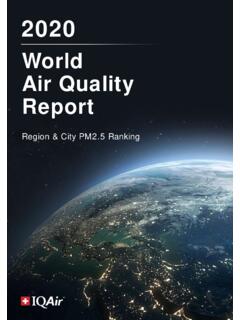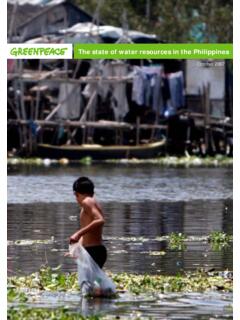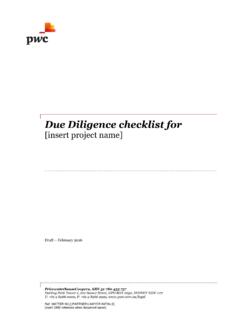Transcription of T h e vu l n erab i l i ty o f n u cl ear p l an ts d u ri ...
1 The vulnerability of nuclear plants during military conflict Lessons from Fukushima Daiichi Focus on Zaporizhzhia, Ukraine 2 March 2022. Briefing - Greenpeace International by Jan Vande Putte (radiation protection advisor & nuclear campaigner for Greenpeace East Asia & Greenpeace Belgium) and Shaun Burnie (senior nuclear specialist, Greenpeace East Asia). Ukraine has a complex and large-scale nuclear power infrastructure. It is a country with 15. operational nuclear reactors of which 9 were in operation on February 28th 2022. In addition, the Chornobyl1 Nuclear Power Plant (NPP), with its unit 4 reactor that was destroyed in 1986, is in Ukraine. It is obvious that in a time of war, the operation of these systems are at risk of disruption with the potential for significant, even severe consequences. Nuclear power plants are some of the most complex and sensitive industrial installations, which require a very complex set of resources in ready state at all times to keep them operational.
2 This cannot be guaranteed in a war. An operational nuclear power plant requires at all times electricity supply to power pumps and water supply to cool its nuclear fuel, both in the reactor and in the adjacent spent nuclear fuel pool. Even when the reactor is shut down, there is an enormous amount of residual heat in the fuel core which requires continuous cooling. Without cooling, the water in the reactor core (and spent fuel pool) begins to heat. In the case of an operational reactor the heating is rapid. The water reaches boiling point and begins to evaporate, and the hot nuclear reactor fuel assemblies are at risk of being exposed to air which then would lead to a thermal reaction of the nuclear fuel assembly cladding and reactor core fuel melt. In the case of nuclear fuel in the spent fuel pool, the highly exothermic chemical reaction is called a runaway zirconium oxidation reaction or autocatalytic ignition, with resultant release of a very large volume of radioactivity. In March 2011, the magnitude earthquake and tsunami in Japan led to the loss of site power at the Fukushima Daiichi nuclear plant the site was no longer connected to the grid.
3 The tsunami that then struck the plant flooded it, including Emergency Diesel Generators (EDGs). and their fuel supply, all needed to power the cooling Even with some level of redundancy in case the EDGs would not be available such as batteries and turbine driven pumps3, all three reactor cores that were in operation at the time of the earthquake and flooding 1. Formerly known by alternative spelling Chernobyl'. 2. Diet of Japan, The National Diet of Japan Fukushima Nuclear Accident Independent Investigation Commission , 2012, :ndljp/pid/3856371 3. IAEA, The Fukushima Daiichi Nuclear Accident. Technical Volume 1/5. 2015. 1. melted down. The spent fuel pond of reactor 4 came close to boiling out, which would have set off a nuclear disaster far worse than the meltdowns in reactors 1-34. So, even without physical damage to the power plant, such as through an intentional or accidental hit by artillery or missiles, a nuclear power plant is very vulnerable to a disruption of the support systems.
4 A nuclear power plant that is in operation requires active systems to remain functioning at all times. This includes many aspects, not only electricity but also cooling water and the continuous presence of qualified personnel to operate the plant. Even under normal functioning, hundreds of workers need to be able to reach the plant from their homes, which is evidently not feasible under war circumstances. In a scenario where there would be a technical disruption, which could be for instance the electricity grid failing, or some of the diesel generators not starting up properly, you would need the ability to quickly mobilise vast amounts of equipment and additional personnel, such as fire brigades or crane operators. The example of Fukushima again demonstrated the need to be able to bring in heavy equipment such as massive cranes and specialised crane operators, fire brigades, heavy pumps etc5. Every technical disruption, for whatever reason, could require a major logistical operation at a nation-wide level which could be severely compromised through the war activities around the power plant.
5 In the context of an armed conflict, it cannot be excluded that a power plant would be isolated from the grid for a longer period of time, which would require emergency diesel generators to remain reliable and have sufficient fuel supply till the grid connection is re-established. Nuclear power plants present unique hazards in terms of the potential consequences resulting from a severe accident. Nuclear reactors and their associated high level spent fuel stores are vulnerable to natural disasters, as Fukushima Daiichi showed, but they are also vulnerable in times of conflict. This brief seeks to explain some of the hazards and potential consequences that exist today in Ukraine. 4. Frank N. von Hippel and Michael Schoeppner, Reducing the Danger from Fires in Spent Fuel Pools , Program on Science and Global Security, Princeton University, Princeton, NJ, , Science & Global Security, 2016, 5. IAEA, 2015. 2. Current status of nuclear power plant operation in Ukraine Source: IAEA Ukraine's nuclear plant operator EnergoAtom reported6 on 1 March that its Zaporizhzhia, Rivne, Khmelnytsky and South Ukraine nuclear plants were operating normally.
6 Of the fifteen commercial power reactors in Ukraine, 9 of the 15 operational reactors are currently operating. The six reactors not operating as of 28 February are: Rivne-1 scheduled outage Khmelnitsky 2 scheduled outage Zaporizhzhia 5 & 6 according to EnergoAtom, were disconnected from the grid and shutdown on 25 February for reasons of operational safety (remaining in cold reserve). Zaporizhzhia 1 - shutdown on 27 February according to EnergoAtom for scheduled maintenance . South-Ukrainian - 3 shutdown on 26 February (remaining in cold reserve). Zaporizhzhia The recent confirmation of armed conflict in the region of the city of Energo and Zaporizhzhia raises the spectre of major risks to Europe's largest nuclear power plant at Zaporizhzhia. There are six Russian VVER-1000/320 reactors (units 1-6) at the site, each with a capacity of generating 950 MWe. There is also a Dry Storage Facility at the plant for high level nuclear spent fuel (DSFSF). As of 2017 there were 2,204 tons of spent fuel in storage at the site 855.
7 Tons inside the spent fuel pools, and 1,349 tons in the Risks 6. EnergoAtom, "Zaporizhzhya NPP continues to operate normally", 1 March 2022, see 7. IAEA, Ukraine National Report: On Compliance with Obligations under the Joint Convention on the Safety of Spent Fuel Management and on the Safety of Radioactive Waste Management , 2017, see .pdf 3. There have been multiple safety issues with the Zaporizhzhia reactors over the decades not least that these reactors are ageing having been designed and built in the 1970's to the 1990s8. Of particular concern, but not exclusively, in the current conflict context, are: 1. Vulnerability to loss of electrical power 2. Spent fuel storage 3. Flood and dam burst risks Zaporizhzhia nuclear plant 1. Emergency diesel generators As noted above, loss of off-site electrical power requires the operation of emergency diesel generators. In 2020, the Ukrainian NGO EcoAction in Kyiv received information from nuclear industry whistleblowers about the functionality of the 20 АС-5600 emergency diesel generators at Zaporizhzhia.
8 Produced by Diesel Energo in St. Petersburg, Russia (former Leningrad). their operation was considered not to be guaranteed, mainly due to a lack of spare parts. On 24. 8. For background and details on Zaporizhia see the archives of Bankwatch, 4. September 2020, the Ukrainian nuclear regulator SNRIU published on its official Facebook page that one of the diesel generators had This incident was scaled as INES 1. In October 2020, in a response to an inquiry by Greenpeace International,10 the State Nuclear Regulatory Inspectorate confirmed monthly testing and full functionality of the diesel generators. There remain however significant doubts about the reliability of Zaporizhzhia's diesel generators, including the current status of the completion of upgrades. The Zaporizhzhia diesel generators should have been upgraded under the Complex Consolidated Safety Upgrade Programme (CCSUP) of Energoatom, financed by a Euratom (EIB) and EBRD loan of 600 Mln EUR. The EBRD is the lead in this programme.
9 In this programme, the diesels should have received modern electronic controls. The final date of completion of the CCSUP has been put back from 2017 to 2023. The on-site diesel generators at Zaporizhzhia are reported to have enough fuel for seven In addition to the on-site emergency diesel generators, the Zaporizhzhia nuclear plant has installed mobile diesel generators. These have been installed as a consequence of the event at Fukushima Daiichi. In 2012 as part of Ukraine's post Fukushima stress test assessment, it is reported that there will be 16 mobile generators units at the Zaporizhzhia nuclear plant, which have diesel fuel to operate for 8 If the diesel fuel tank is continuously re-filled, the generators are reported to be able to operate indefinitely. In 2013 it was reported that, To ensure power supply in case of extreme events that may cause long-term station blackout, separate mobile kV and kV diesel generators will be used to feed at least one emergency power distribution panel.
10 13. In case of failure or impossibility to use regular Diesel Generators, there are measures to provide NPP sites with mobile pumping units and diesel generators. It is additionally planned to develop measures for their refueling if long-term performance is needed. 14 As noted in this briefing the operation of these safety systems, including securing additional fuel supply during armed conflict, is a major concern. The reliability of the equipment installed at the Zaporizhzhia nuclear plant is certainly in question, with a Austrian government assessment of the safety risks at the Zaporizhzhia reactors concluding in 2017 that, The documents provided and available lead to the conclusion 9. State Nuclear Regulatory Inspectorate of Ukraine, October 2020, 10. Jan Haverkamp, Functionality of diesel generators at the NPP Zaporizhzhia Request for access to information , Greenpeace International letter to Mr. Hryhorii Plachkov president of the State Nuclear Regulatory Inspectorate of Ukraine, 14 October 2020.













